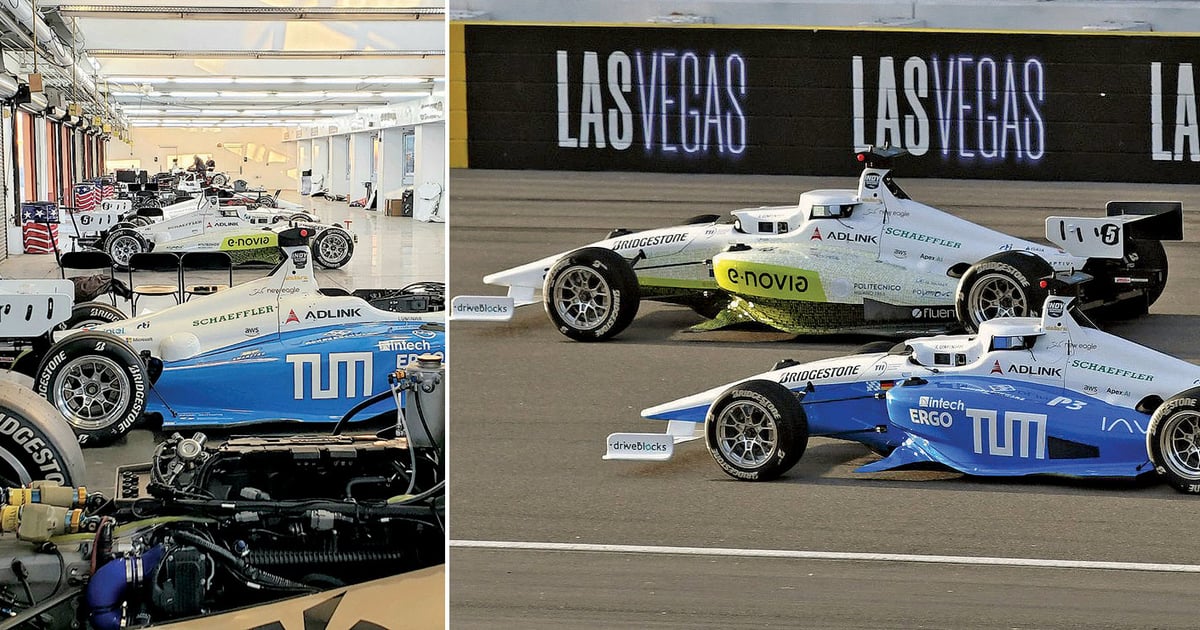
When the Indy Autonomous Challenge racing series made its CES debut last year, the concept of self-driving cars traveling at speeds approaching 170 mph attracted considerable attention.
“There was, I think, a lot of shock and awe that it was even possible in today’s day and age,” said Paul Mitchell, CEO of Energy Systems Network, the race producer.
The Indy Autonomous Challenge returns to the Las Vegas Motor Speedway on Saturday, Jan. 7, with bigger brains and brawn powering its race cars.
Approximately 10,000 event-goers have registered to attend the race as of Dec. 20. That’s a five-fold increase from the 2,000-person crowd last year, an audience limited by pandemic-related restrictions, Mitchell said.
Nine university-affiliated teams are eligible to compete. Their software must still pass safety checks before they qualify. Those that do will showcase hardware improvements that include bigger turbochargers on the identical Dallara AV-21 base vehicles assigned to each team and new on-board computers provided by German supplier dSPACE, a race sponsor.
Those improvements allow for a more sophisticated race. Cars will still race two at a time in head-to-head competition. But revised rules will permit them to change their race lines and use more defensive maneuvers. In the bracket-style competition, winners move on until there is an overall victor. Time trials and elimination rounds begin at 10 a.m. PST; the semifinals and finals will be held from 1 to 3 p.m. PST.
Competitors have enhanced their capabilities in detecting anomalies in the behavior of their opponents, a new skill set on display at the Indy Autonomous Challenge’s November session at Texas Motor Speedway.
“That’s a subtlety that, unless you’re into racing and autonomous vehicles, maybe doesn’t seem significant, but it’s a really big deal,” Mitchell said. “It’s the difference between autonomous cars operating at high speeds but not like humans, versus driving like a human race car driver. They can operate at high speeds and make adjustments when something totally unexpected happens.”
Technology has long trickled from motorsports into conventional passenger cars, and Mitchell’s hopes are the same for autonomous-driving software that better responds to traffic conditions in real time. Developing technology that accelerates the widespread deployment of autonomous vehicles is a central goal of the Indy Autonomous Challenge.
Public roads would be a dangerous place to push technology and components to their limits. That makes the race track a natural place to challenge the performance envelope.
“The nature of racing is to push these cars and find out where the limit is,” said Madhur Behl, assistant professor of computer science at the University of Virginia.
He leads the school’s Cavalier Autonomous Racing Team in the Indy Autonomous Challenge events.
Speed remains a key element. In April, the PoliMOVE team, which won last year’s IAC in Las Vegas, set a world record for fastest autonomous land operation.
The team, which comprised members from the Politecnico di Milano (Italy) and University of Alabama, reached 192.2 mph on the tarmac at the Kennedy Space Center in Cape Canaveral, Fla.
Speeds at the event in Las Vegas could approach that depending on weather and track conditions.
Sometimes limits are pushed to the point of failure. In 2022, the Virginia team’s vehicle crashed at 125 mph. Luckily, the crucial electronics housed in the cockpit where a human driver would normally sit emerged unscathed.
“Every single race has been a learning exercise,” Behl said. “We can look at what is working well and what has room for improvement.”
Those exercises will get trickier in the months ahead at Indy Autonomous Challenge events. So far, races have been held on oval courses in Indianapolis, Las Vegas and Austin, Texas.
In 2023, Indy Autonomous Challenge races will be held on road courses, Mitchell said. He did not disclose the location of those races but said a two-year agreement had been reached for races in 2023 and 2024, details of which would be shared during CES.